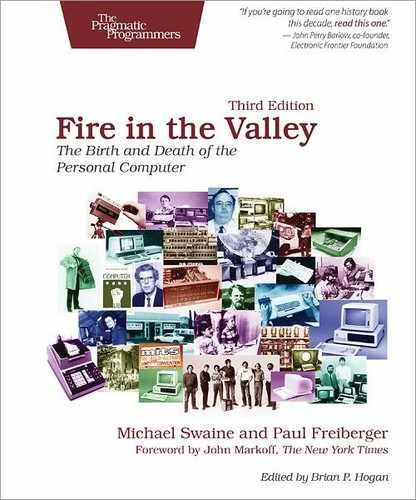Foreword to the Third Edition
Paul Freiberger, Michael Swaine, and I arrived at about the same time in late 1981, at a funky little publication that had recently been renamed InfoWorld. Until the summer of 1981, InfoWorld had been known as the Intelligent Machines Journal, a hobbyist journal written for a small but rapidly growing community of computing enthusiasts. The Intelligent Machines Journal had been founded by Jim Warren, an itinerant former schoolteacher who had also created the West Coast Computer Faire. When he decided to sell his then quasi-academic publication, he found an eager buyer in Patrick McGovern, the chairman of the International Data Corporation, whose flagship weekly, Computerworld, was the unofficial organ of the mainframe-computer industry.
McGovern had his ear to the ground, and he had realized early on that a new computer industry was emerging that had little in common with the stuffy East Coast–based computer companies. The transformation of Intelligent Machines Journal was just one in a series of events between 1977 and 1981 that marked the evolution of a hobbyist subculture into the world’s most dynamic industry. The three of us couldn’t have arrived at a better time. The PC hobbyist era was ending, but in its place was thriving an equally wild, absolutely out-of-control group of small businesses—populated by remarkable and quirky characters—on their way to becoming major corporations.
Overnight, InfoWorld became a perfect perch from which to watch history take place. Everything was moving rapidly, and the publication we had found ourselves working for was attempting to define itself while the world was being turned upside down by the microprocessor. One moment InfoWorld tried to be a Rolling Stone to the personal-computer industry; the next moment it set out to be a Sports Illustrated.
Few of us were trained journalists, but like the fledgling industry we were covering, we made it up as we went along. It was soon obvious that the world was taking notice of the PC. On an almost weekly basis, people from around the country would simply appear at our offices in downtown Palo Alto, having made their way to the Mecca of Silicon Valley looking for jobs or connections.
At InfoWorld we were close to history in the making—sometimes too close. One day I walked into Paul Freiberger’s office, a small windowless corridor, only to find him in a tense conversation with Steven Jobs. Jobs was yelling at him because Paul was about to break the story of the Lisa and the Macintosh, and Jobs was accusing him of helping the Japanese take over the American computer industry.
This proximity of its authors to the enterprises that birthed the microcomputer industry sets Fire in the Valley apart from the dozens of other attempts to tell the story of the computing revolution. Paul and Michael lived through a remarkable period of history, and their book captures the spirit of the personal-computer revolution.
Originally published in 1984, Fire in the Valley was the first, and is still the best, account of the people who created what venture capitalist John Doerr has called the “single largest legal accumulation of wealth in the century.”
More recent histories of the personal computer have tended to devolve into accounts of the legends of William Gates, Steven Jobs, and the Xerox Palo Alto Research Center. Fire in the Valley goes deeper, telling the story of what came before. Freiberger and Swaine’s account of the history of the Homebrew Computer Club still stands as the definitive tale of a remarkable anarchist assembly of engineers, hackers, and fellow travelers that began as a genuine counterculture and ended by changing the world.
There is also a trend in computer histories today to reject the impact of culture and politics in the development of the personal computer. But even a casual reading of Fire in the Valley clearly demonstrates that the personal-computer industry, and its emergence in Silicon Valley in the 1970s, was a direct outgrowth of a remarkable period in the suburban region that surrounds Stanford University.
It was a particular chemistry—not just greed and not just engineering, but also a strain of passionate political purity best expressed by young people such as Lee Felsenstein, inventor of the Sol and designer of the Osborne 1—that gave rise to the personal-computer industry.
First published three decades ago, this new edition of Fire in the Valley has been expanded with both additional reporting and new chapters. This new edition covers the development of the post-PC era and the arrival of mobile devices, $2 apps, and their connection to the original vision of the personal computer.
It covers the return of Steve Jobs to Apple and the impact he had again, including Apple’s transition to the mobile, connected world. Paul and Mike also track more recent developments, from the emergence of the Internet to post-Gates Microsoft and Bill’s move to the Gates Foundation. Additionally, they chart the rise of the open source software movement and its meaning, impact, and potential, as well as its connection to the ethos of the earlier homebrew era. Finally, they explore the conflict between empowering individuals and loss of privacy, placing us directly in the Snowden Age.
Even Steve Jobs came to admire the first edition of this book, saying, “Reading it made me cry, thinking about those early days.”
Fire in the Valley has stood the test of time well. It remains a great adventure that gives the reader a sense of being close to a historical movement that is still playing itself out.
